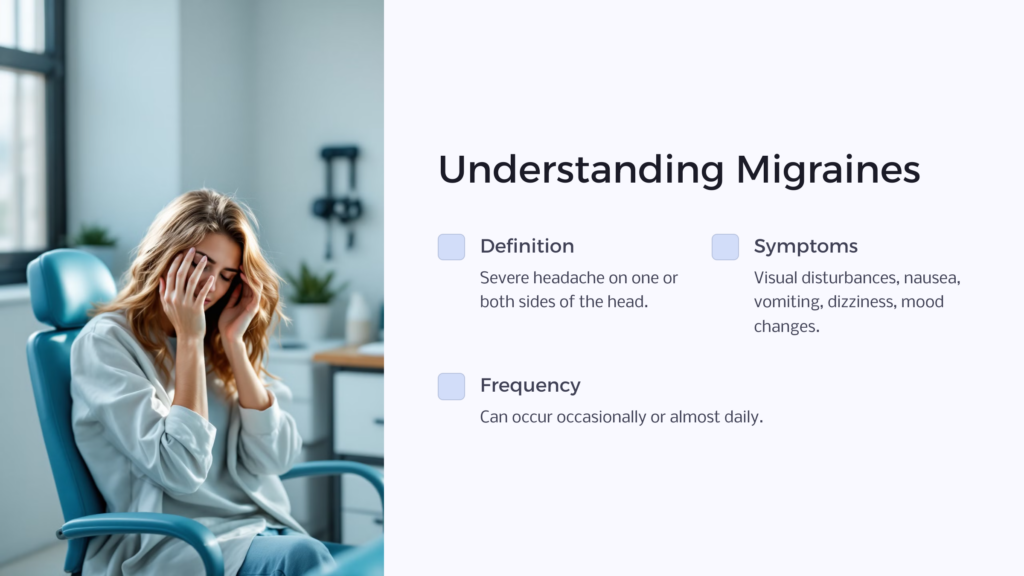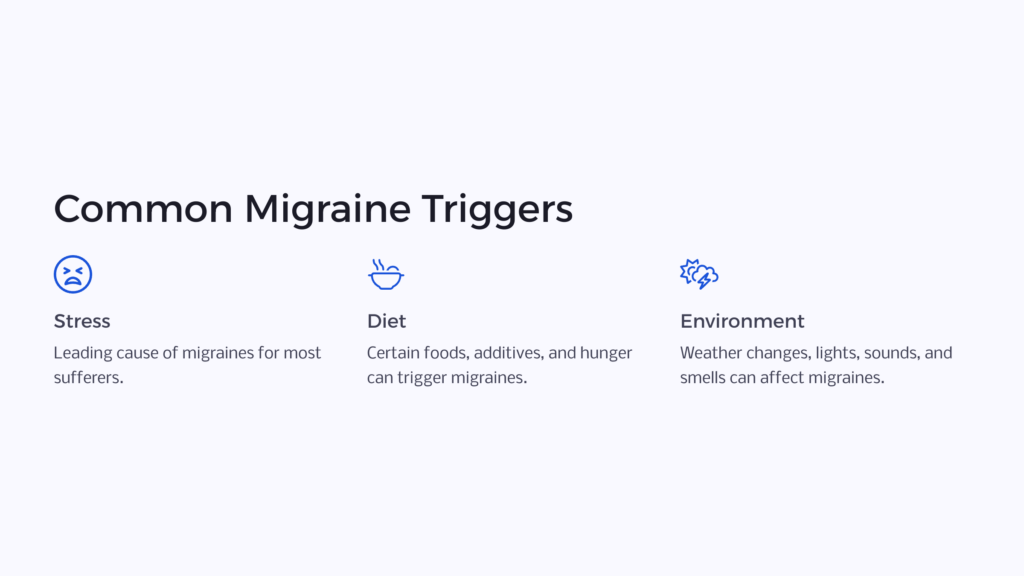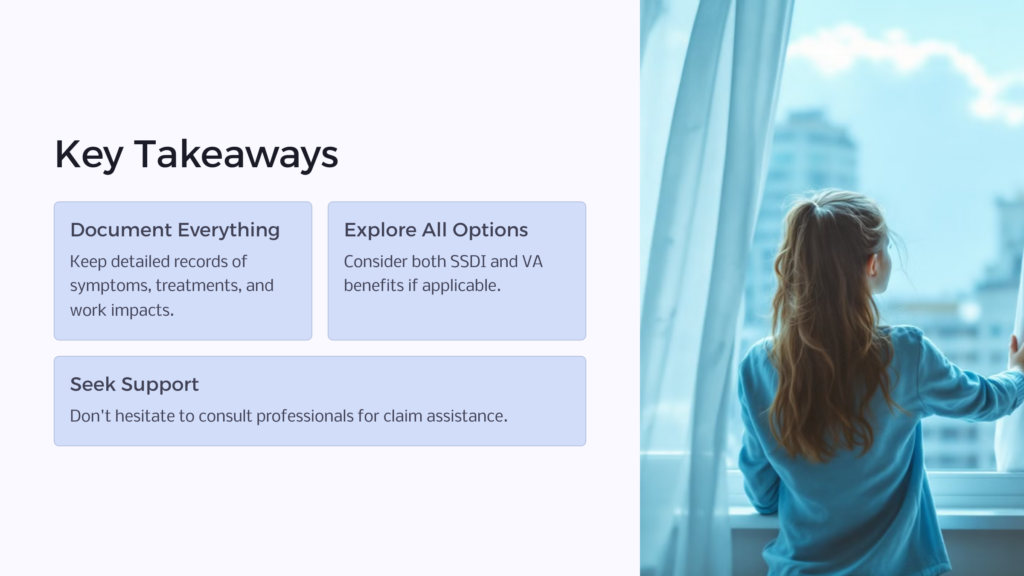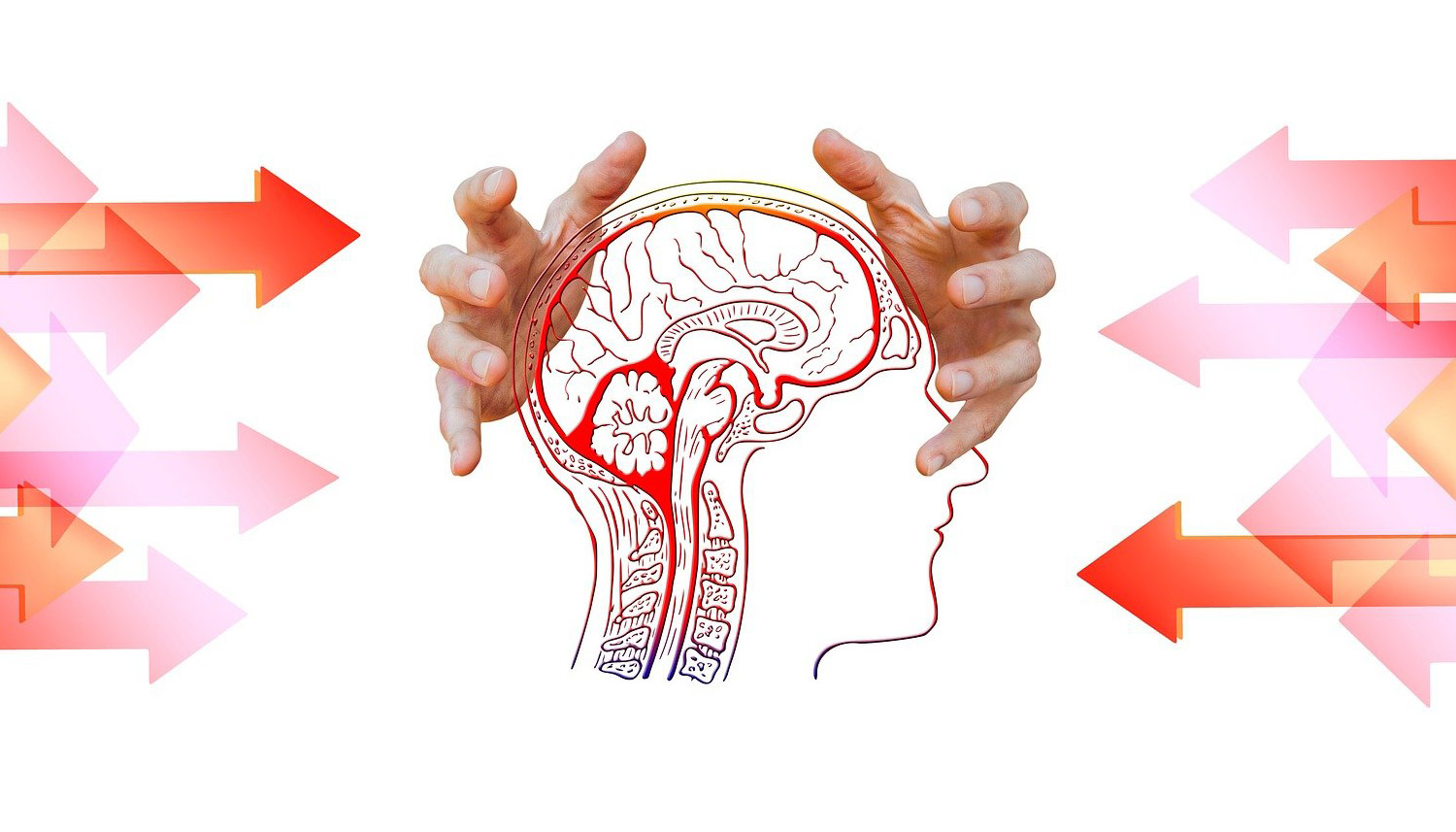Chronic migraines can be debilitating for those who suffer from them. In some cases, a person with a chronic migraine headache may qualify for Social Security Disability Insurance (SSDI) and disability compensation if the migraine sufferer finds it challenging or impossible to work. Your doctor can help you prove that your chronic migraine symptoms qualify you for migraine disability benefits.
Defining Migraines

A migraine is a headache condition that causes severe pain on one or both sides of the head. People who suffer from migraines may get occasional migraines that don’t affect their everyday lives or workability. Other migraine sufferers experience migraines almost every day, leading to visual disturbances, nausea, vomiting, dizziness, mood changes, and other disruptive symptoms.
A migraine often feels like a cluster headache. However, cluster headaches usually disappear for months or even years, while migraines tend to happen more frequently. If you experience a chronic headache diagnosed as a migraine that interferes with your ability to work, your migraines may qualify you for Social Security disability benefits.
Social Security Disability Benefits for Migraines

Migraines fall under the umbrella of an invisible disability because they aren’t physically noticeable to others. However, for migraine sufferers, they can be incredibly painful and incapacitating. Some migraines last for hours while others last for days. Either way, if you experience a migraine headache frequently enough, you should consider submitting a disability claim for SSDI benefits.
One of the simplest ways to qualify for Social Security disability based on your migraines is if they result from another condition you have been diagnosed with. For example, anxiety, depression, post-traumatic stress disorder, neurological disorder, stroke, and high blood pressure can cause episodic migraine symptoms. If you have both conditions together, it could be much more straightforward to get your claim approved.
Because standalone migraine disease can be more challenging to diagnose and prove, you could have a more challenging time obtaining disability benefits. But that doesn’t mean you can’t get one. The SSA considers several points when evaluating your migraine symptoms, like your migraines’ frequency and severity, and how they limit your daily capabilities.
When reviewing medical evidence, the SSA disability examiner determines if your symptoms, like pain, severe headache, and vomiting, lead to functional limitations and an inability to work. The more medical evidence your doctor provides, the higher your chances of a disability insurance claim approval.
It might be best for you to consult a disability attorney for migraine disability benefits. Your attorney can explain what information you need to qualify, how to apply for benefits properly, and what you need to do should you wish to appeal the SSA’s decision.
11 Things That Can Trigger a Migraine

Migraines come in a lot of forms with different symptoms and severities. People who experience frequent migraines may also find that there are several triggers for their migraines. The following are some of the most common causes of migraines:
1. Stress
Stress is a leading cause of migraines for most migraine sufferers. Like stress can cause tension headaches in some, it can lead to migraines for those who are more prone to them. Frequently anxious people can experience migraines more often than others, resulting in severe headaches and other migraine symptoms that last hours or days.
If you believe that stress or anxiety causes your migraines, it’s crucial to seek help in the form of therapy, meditation, exercise, or other ways that can help you relax and likewise benefit your mental health. If you apply for SSDI benefits, be sure to note in your application what stress-reducing methods you’ve tried and whether they’ve worked.
2. Alcohol and Caffeine
What you put into your body may also impact your migraines. Chronic headache sufferers who drink alcohol or caffeinated beverages, like soda, coffee, and tea, regularly may experience frequent migraines.
It’s common for people who drink alcohol to experience a headache within one to a few hours after starting to drink. These headaches can come on much more strongly for migraine sufferers, even causing a migraine attack.
While experts don’t believe caffeine causes headaches directly, it could cause withdrawal headaches when a person who drinks a lot of caffeine hasn’t had any in a while. For migraine sufferers, this can lead to severe migraine symptoms. The National Headache Foundation (NHF) suggests scaling back how much caffeine you drink to curb this effect.
3. Dehydration
When your body isn’t getting enough water, you might experience dehydration, which has already started occurring if you feel thirsty. Dehydration is terrible news for migraine sufferers, as it can make migraine symptoms more severe.
Before you have a migraine attack, your body enters a prodrome period for a few days or hours. During this time, you might need to urinate more frequently, which means your body loses more water than usual and boosts the risk of dehydration. Studies show that increasing water intake of 1.5 liters per day curbed the intensity and longevity of its participants’ migraine headaches.
4. Exercise or Physical Exertion
Many migraine sufferers note that their headache pain often begins after exercise or other physical exertion types, such as physical labor. One study found that 38% of people with migraines listed exercise as a trigger for their migraines, which often coexisted with neck pain.
However, other research has also suggested that regular exercise could reduce the severity of a headache disorder and its symptoms. This effect results from natural pain-reducing endorphins your body releases while you exercise, which may contribute to reduced headache pain and migraine attacks.
5. Medication
Some medications may be responsible for chronic migraine headaches if you need to take them regularly. Medications containing hormones and caffeine are some of the more common contributors, but you could also experience migraine symptoms from blood pressure medication, pain medication, and vitamins.
If you experience migraines, talk to your doctor before starting a new medication. Ask about any potential migraine-related side effects, and if there are any alternative medications without severe migraine side effects.
6. Lights, Sounds, and Smells
Migraines are notorious for stemming from environmental stimuli, like lights, noises, and smells. For example, a strong candle could lead to a full-blown migraine for some individuals, while others might experience migraines more from flashing lights or loud music.
Experts believe that environmental stimuli trigger migraines because migraine sufferers tend to have a lowered ability to perceive and process sensory stimuli, similar to what happens to someone with a sensory processing disorder. Shifts in the environment can make it challenging for people with migraines to function regularly, affecting both their personal and workplace lives.
7. Weather
Just like weather changes can make your back or knees hurt, it may also affect your migraine symptoms. There is reason to believe that weather can shift brain chemicals, and that shift may trigger a migraine. Heat, cold, wind, sun, and extreme humidity each have the power to cause migraines, especially if you’re very sensitive to sensory stimuli.
8. Food, Food Additives, and Hunger
Depending on your body and how it processes food, you might experience more severe migraine symptoms when you eat specific foods. Some common food migraine triggers include citrus fruits, onions, and cheese. Food additives, like aspartame sweetener and monosodium glutamate (MSG), may also cause migraines.
Hypoglycemia, or low blood sugar, can also cause headaches and migraines. Blood sugar drops when you’re hungry because you haven’t eaten in a while. If you experience migraines when you’re hungry, try adding some healthy snacks to your daily diet.
9. Hormonal Changes
Women are more prone to migraines than men, but even more, women tend to experience migraines once they reach the typical reproduction age. Research suggests that estrogen – a female sex hormone – may be a culprit in causing migraines.
This could explain why some women have migraines more often during menstruation. Pregnancy and birth control are also contributing factors for migraines in many women who experience hormone-related migraine symptoms. Women who do get hormonal migraines may see a decrease in their severity when they hit menopause. Sometimes, migraines can disappear entirely during menopause.
10. Lack of Sleep
Migraines can affect your sleep habits because they can occur during your sleep, primarily if you use migraine medication that wears off during your regular sleep schedule. However, a lack of sleep can also contribute to migraines.
Not getting enough sleep may cause your body to increase specific proteins associated with more frequent migraines. One protein known as P2X3 may also increase in the body when you don’t get enough sleep. This protein has connections to chronic pain, which could explain why your migraines feel worse when you had a rough night of sleep.
11. Genes
Although migraines aren’t always genetic, they could be. If you have a parent or sibling who suffers from migraines or a similar headache disorder, there’s a good chance that the condition runs in the family.
Research estimates that there’s somewhere between a 30% to 60% chance that a person with migraines inherited them through their family genetics. Still, medical experts search for a clear answer as to how strongly migraines may run in families and whether genetics determines how severe your migraine symptoms could be.
Disability Benefits for Chronic Migraines
It is possible to qualify for SSDI and receive disability compensation with a migraine-related disability if you experience severe migraine symptoms frequently enough that it interferes with your ability to work. The SSA will consider whether you have documented medical evidence for your migraines and how much your symptoms limit your everyday activities. It will also consider whether your migraines will likely last the past year.
If you’ve missed several days of work due to migraines, it’s in your best interest to provide proof of them to the SSA with your claim. You should also ask your doctor to send your medical records of any visits or tests you’ve had associated with your migraine symptoms.
Other conditions may be present alongside migraines, like neurological symptoms, asthma, or stroke. In that care, be sure to send evidence of your coexisting condition(s) too.
VA’s Migraine Rating System
A migraine is a headache characterized by intense pain often accompanied by vomiting, nausea, sensitivity to light and sound, blurred vision, and lightheadedness. It can last for hours or days, and the pain could be severe and debilitating, affecting your daily activities.
A migraine diagnosis has a maximum VA rating of 50%. This means that a veteran with a migraine may qualify for up to 50% of disability compensation because of this condition. However, this isn’t an automatic rating because there are many stages of migraine under consideration:
- 0% VA Disability Rating – Occasional migraines or symptoms that don’t include prostrating attacks.
- 10% VA Disability Rating – Prostrating attacks that occur every two months.
- 30% VA Disability Rating – Prostrating attacks that occur once a month.
- 50% VA Disability Rating – This is the maximum VA disability rating for migraines, and it’s characterized by frequent prostrating and prolonged attacks that cause severe difficulty.
The word “prostrating” typically means the migraines are so severe and debilitating that you must stop all activity or lay down for a prolonged period because of exhaustion and physical weakness. Also, it may require you to seek medical attention or take medication.
However, if you suffer migraines and related health conditions that have a profound impact on your life, you may wonder how you can increase your overall VA disability rating beyond 50%.
That’s where Total Disability Individual Unemployability (TDIU) and secondary conditions are crucial pathways that can help you increase your disability rating.
Secondary conditions are additional medical problems that directly result from a service-related disability.
For example, if you suffer from migraines, you may also suffer from health conditions like sleep disorders or depression because of life disruptions and chronic pain caused by the migraines.
If these secondary conditions are deemed as related to your service-connected migraines, they can result in a higher combined disability rating and more benefits for you and your family.
Secondary conditions for migraines include:
- Anxiety
- Depression
- Insomnia
- Gastroesophageal reflux disease (GERD)
- Sleep Apnea,
- Tinnitus
- Vertigo
When you have two or more disabling conditions, the VA combines your disability ratings to get the final rating. However, they don’t just add them together, which could lead to a rating of over 100%. Instead, they use a table of combined disability ratings to generate a rating and round it to the nearest 10%.
For instance, a 10% tinnitus rating and a 30% migraine rating led to a rating of 37. The VA then rounds that to give you a final disability rating of 40%. If you suffer from more than two disabling conditions, the VA will continue to use the table to combine your disability ratings until it gets a final disability rating.
Working Through Claim Denial
Regardless of how much information you send to the SSA, you still could receive a denial of your claim. Consider consulting a disability attorney to help you complete your claim and file an appeal, if necessary. Your disability attorney can also guide you through the appeals process to explain anything you don’t understand and represent you during a hearing with an Administrative Law Judge.
Alongside applying for Social Security disability benefits, you can also submit a VA disability claim through Veterans Affairs (VA) if your neurological conditions are possibly linked to your military service, such as Gulf War Syndrome. After applying for a VA disability claim, you can be given a VA disability rating, and possibly receive VA disability benefits. It’s important to go through your medical record and provide as much medical evidence as possible to support your claim in order to receive disability benefits. Similar to the Social Security Administration application, you still could receive a denial of your claim and not receive any VA benefit unless you were to appeal your denial as well.
You shouldn’t feel like you don’t have options as a migraine sufferer. A disability determination in your favor could be right around the corner to give you some relief as you continue to seek care for your migraines.

 Benefits.com Advisors
Benefits.com Advisors
With expertise spanning local, state, and federal benefit programs, our team is dedicated to guiding individuals towards the perfect program tailored to their unique circumstances.
Rise to the top with Peak Benefits!
Join our Peak Benefits Newsletter for the latest news, resources, and offers on all things government benefits.




















